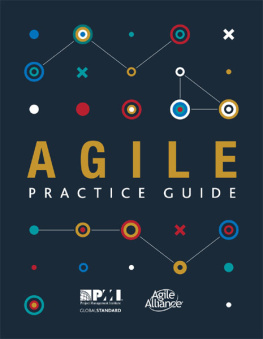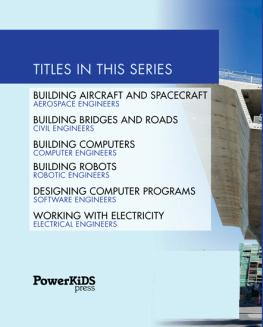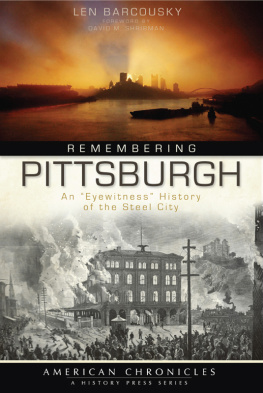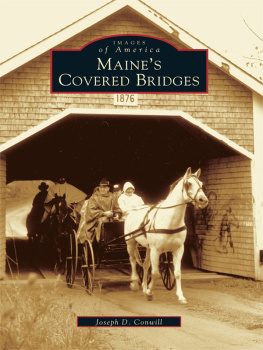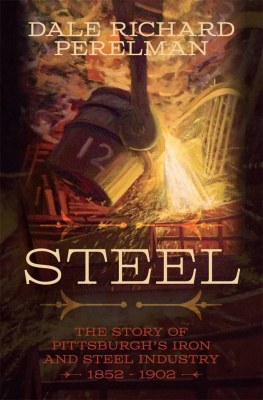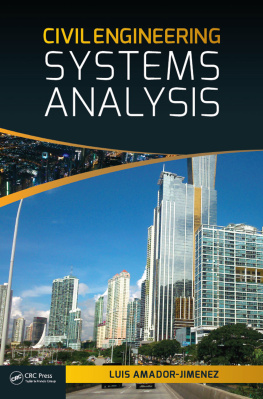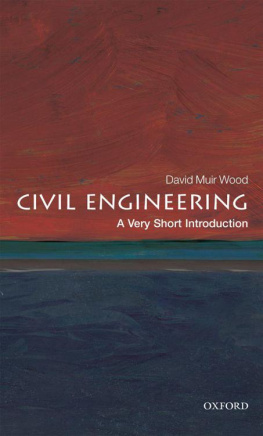


Published by The History Press
Charleston, SC
www.historypress.com
Copyright 2018 by American Society of Civil Engineers Pittsburgh Section
All rights reserved
First published 2018
e-book edition 2018
ISBN 978.1.43966.506.0
Library of Congress Control Number: 2018942435
print edition ISBN 978.1.62585.969.3
Notice: The information in this book is true and complete to the best of our knowledge. It is offered without guarantee on the part of the authors or The History Press. The authors and The History Press disclaim all liability in connection with the use of this book.
All rights reserved. No part of this book may be reproduced or transmitted in any form whatsoever without prior written permission from the publisher except in the case of brief quotations embodied in critical articles and reviews.
To past, present and future civil engineers and ASCE Pittsburgh Section members.
CONTENTS
ACKNOWLEDGEMENTS
This publication is part of the centennial celebration of the American Society of Civil Engineers (ASCE) Pittsburgh Section. We gratefully recognize the legacy of past and current Section leaders and members who, since its founding in 1918, have supported the Sections purpose of providing opportunities to improve and develop technical and professional skills of civil engineers, and provide accurate information to support responsible development of public policy that governs and affects the profession of civil engineering.
The authors recognize our local academic institutions for shaping the highest quality of civil engineers for societys benefit. These institutions have advanced our profession through theoretical and applied research, educational training, collaborations with local industry and government and by maintaining a wealth of accessible technical resources and professional outreach. We convey our deepest appreciation for the innumerable contributions to civil engineering, and thus to this publication, from Carnegie Mellon University, Geneva College, Point Park University and the University of Pittsburgh.
To our families, friends, colleagues, mentors, collaborators and employers who provided research, editorial content, knowledge, resources, understanding andforemostpatience and support: you have our deepest gratitude and lasting appreciation.
The content of this publication was enriched by the selfless third-party reviews provided by Thomas G. Leech, PE, and James L. Withiam, PhD, PE. Tom and Jim, we heartily thank you for your valuable contributions.
Special gratitude for their collaboration goes to David A. Dzombak, Ralph W. Gilbert Jr., Radisav D. Vidic, Jelani J. Virgo, Helen Wilson, Lauren Winkler and David E. Wohlwill.
Written on behalf of the editorial team of Engineering Pittsburgh: A History of Roads, Rails, Canals, Bridges and More.
N. CATHERINE BAZN-ARIAS, PhD, PE, D.GE, PMP, F.ASCE
Publication Coordinator
GREGORY F. SCOTT, PE, M.ASCE
TODD M. WILSON, MBA, PE, M.ASCE
Publication Facilitators
Prologue
CIVIL ENGINEERS, ASCE AND THE PITTSBURGH REGION
[A]nd upon whom will rest the responsibility for getting us out of this predicament if not upon the engineerthe final repository of all the toughest problems of humanity?
Winters Haydock, chief engineer, Citizens Committee on City Plan of Pittsburgh, November 22, 1921
By N. Catherine Bazn-Arias, PhD, PE
In 2018, the American Society of Civil Engineers (ASCE) Pittsburgh Section celebrates its 100th anniversary. But for more than a century, civil engineers have been part of Pittsburghs development and resilience, as well as its transformation from a military fort to a vibrant, forward-thinking city. For the past century, the ASCE Pittsburgh Section has proudly been part of the support system of our local civil engineers. This first centennial publication aims to highlight some of the civil engineering achievements in Pittsburgh and its surrounding regionsthe works that link our city and its environs to our nation.
To begin this journey, let us establish our framework. Founded in 1852, ASCE is the nations oldest engineering society. Its mission is to deliver value to our members, advance civil engineering, and protect the public health, safety, and welfare. As described by ASCE, Civil engineers design, build, and maintain the foundation for our modern societyour roads and bridges, drinking water and energy systems, sea ports and airports, and the infrastructure for a cleaner environment, to name just a few. In Pittsburgh, civil engineers are responsible for our roads, rails, bridges, tunnels, waterways and highways. The design of canals, locks and dams and water and wastewater systems is the work of civil engineers. These civil engineering works provide clean water, control flooding, harness hydraulic power and typically are part of the critical infrastructure that sustains our socioeconomic resilience. Through instruction at our local universities and colleges, Pittsburghs civil engineers have transformed a once roughened terrain prone to landslide and floods into one of the most livable cities in the country.
DID YOU KNOW?
The Pittsburgh Section was initiated in 1917 but was not ratified until 1918. It is theorized that the onset of the influenza pandemic of 191819 caused the delay.
How did present-day Pittsburgh develop? To answer that question, we step back to the time when the first Native Americans arrived in the region. As attested by sites such as the Meadowcroft Rockshelter, located about thirty miles southwest of Pittsburgh, people have lived in our region for at least sixteen thousand years. As the first settlers looked for shelter and food, they had to rely on innovation, ingenuity and resourcefulness to establish water collection systems, trade routes and settlements that would weather seasonal changes and provide protection. These settlers realized that the Monongahela, Allegheny and Ohio Rivers were sources of food, water, transportation and, alas, floods. Thus, the need to design, build and maintain infrastructure in our regionand the need for civil engineerswas born out of the need to coexist with topographic and climatic benefits and challenges.
In this book, we journey back to the 1600s, when the city of Pittsburgh and the Commonwealth of Pennsylvania were yet to be born. From descriptive, phonetic Native American names such as Monongahela (falling banks), Youghiogheny (contrary stream) and Punxsutawney (town of the mosquitoes) to our present-day state borders, the Pennsylvanias Borders chapter allows us to witness charters, land disputes and reconciling agreements enacted by our young United States government. We will traverse the Allegheny Mountain by the Allegheny Portage Railroad, crossing incline planes for the first time, using wooden ties instead of stone sleepers and constructing reservoirs on the east and west side of the Allegheny ridge to supply water for canals. The canals that made the navigation of our river network feasible are vividly described in our Canals chapter. The daunting history that made the Pennsylvania, Beaver Division, Erie Extension and Lake Erie to the Ohio Canals realities comes to life working around budding towns with limiting construction equipment and transportation and scarce budgets, as well as how these were overcome.
Next page






